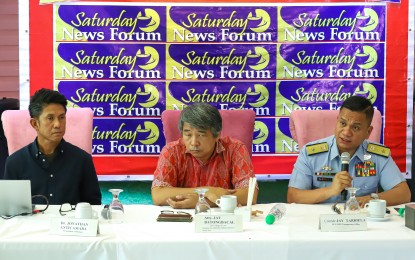From the Philippine News Agency (May 4, 2024): PCG exec: Damaged WPS resources strengthen case build-up vs. China

EXPERT TALKS. University of the Philippines-Diliman professors Dr. Jonathan Anticamara of the Institute of Biology and lawyer Jay Batongbacal of the College of the Law, and National Task Force for the West Philippine Sea spokesperson and Philippine Coast Guard Commodore Jay Tarriela (from left) guest at the Saturday News Forum at Dapo Restaurant, Quezon City on May 4, 2024. Tarriela said they respect the guidance of their Commander-in-Chief, no less than President R. Marcos Jr., that the Philippines should not be the reason for escalating tension in the WPS and for China to justify its aggression; Anticamara said they have studies to prove that China is causing environmental destruction and altering the sea features in the WPS; and Batongbacal said the Philippines can follow up the previous findings in the arbitration against China for actively and deliberately destroying coral reefs as a result of its reclamation activities. (PNA photo by Robert Oswald P. Alfiler)
MANILA – The marine resource assessment that showed damaged resources within the Philippines’ exclusive economic zone (EEZ) will be part of the evidence being gathered to support a case build-up against China for environmental destruction and degradation.
National Task Force for the West Philippine Sea (NTF-WPS) spokesperson and Philippine Coast Guard Commodore Jay Tarriela said at the Saturday News Forum in Quezon City that the findings of Dr. Jonathan Anticamara have been presented to the investigating bodies, pending the arrival the completion of the official scientific study.
Anticamara is a professor at the University of the Philippines (UP) Institute of Biology in Diliman, Quezon City.
“From the Philippine Coast Guard together with BFAR (Bureau of Fisheries and Aquatic Resources), since we are the lead agencies in doing this research assessment with support, of course, from the University of the Philippines, we’re going to formally forward this to the NTF-WPS,” Tarriela added.
Anticamara and his team conducted the marine resource assessment in Pag-asa Cays 1, 2 and 3 to provide scientific basis on the destruction of marine resources inside the EEZ.
“Now, in the case of the pile of rubble, what I found is that there are many characteristics of this pile of rubble and I’ll present the details of these characteristics that kind of convinced me that this is not a typical island formation that’s basically formed by nature. Many of these characteristics suggest that most likely these piles of rubble are somewhat… siguro ano (maybe), made by human,” he said.
Another key finding is that many of the corals in Pagasa Island in the Kalayaan Island Group and the cays are degraded.
“So, ibig sabihin ng (the meaning of) degraded is that many of the corals are now small, many of the large corals are now dead and there’s not a lot of live corals per unit area, so kaunti na lang ‘yung buhay (there are few of them that are still alive). And if you look at fish, it’s the same, all the areas that we surveyed, we swam, we dove… there’s not a lot of fish anymore,” Anticamara said.
Main suspect
Tarriela said the operations of Chinese vessels, which far outnumber Filipino ships, cause massive damage to coral reefs.
China also has the experience and capability in reclamation activities in the South China Sea.
“So, if there is one country that we need to hold accountable dito sa (for the) damage ng environment na ito, sa ating (here, in our) coral reef dito sa (for the damage in our coral reefs in the) cays, that will only be the People’s Republic of China,” he said.
Lawyer Jay Batongbacal of the UP College of Law, also the director of the Institute for Maritime Affairs & Law of the Sea, said China’s activities are violations of the international law because they contravene obligation to preserve and protect the marine environment.
“At the very least, itong destruction ng (the destruction of the) corals and deliberate alteration ng (of the) marine environment, puwedeng maging basehan iyon ng isa pang kaso na pa-follow up doon sa 2016 arbitration (it can be a solid basis for another case to add to the 2016 arbitration),” Batongbacal said.
The 2016 arbitral ruling sided overwhelmingly with the Philippine claims in the WPS and disregarded China’s nine-dash line.
Other options
Aside from the usual diplomatic protest, Batongbacal said there are other legal options for the Philippines, like calling for a fact-finding mission before an international organization, leading to another case litigation.
Department of Foreign Affairs spokesperson Undersecretary Teresita Daza said in a forum on Friday that the PCG must file an official report as basis for the next action, whether it would be a diplomatic protest or a summon.
Tarriela assured the Coast Guard shares the level of emotion the public is experiencing and brushed off public criticisms on the response to China’s provocative actions.
“We have a chain of command. We respect the guidance of our President (Ferdinand R. Marcos Jr.). The guidance of the President is that we should not be provoked, we should not be the reason of intensifying the escalation for China to justify to once again bringing the next level of aggression, kung anuman ang plano nilang gawin (whatever they’re thinking of next),” Tarriela said. (With reports from Ferdinand G. Patinio, PND/PNA)
https://www.pna.gov.ph/articles/1224044

No comments:
Post a Comment
Note: Only a member of this blog may post a comment.